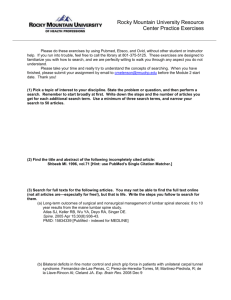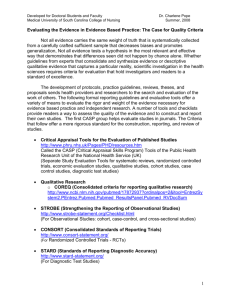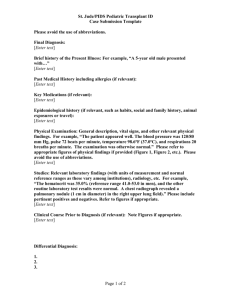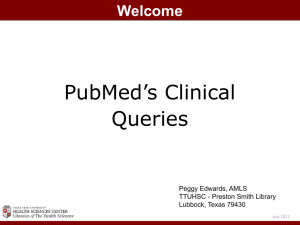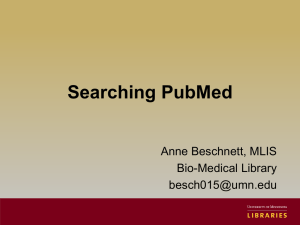3_Search_engine_Master
advertisement
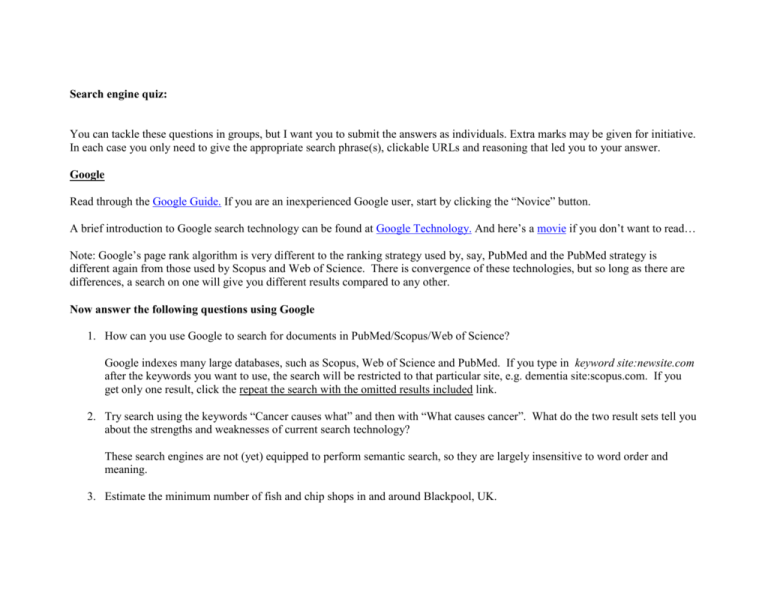
Search engine quiz: You can tackle these questions in groups, but I want you to submit the answers as individuals. Extra marks may be given for initiative. In each case you only need to give the appropriate search phrase(s), clickable URLs and reasoning that led you to your answer. Google Read through the Google Guide. If you are an inexperienced Google user, start by clicking the “Novice” button. A brief introduction to Google search technology can be found at Google Technology. And here’s a movie if you don’t want to read… Note: Google’s page rank algorithm is very different to the ranking strategy used by, say, PubMed and the PubMed strategy is different again from those used by Scopus and Web of Science. There is convergence of these technologies, but so long as there are differences, a search on one will give you different results compared to any other. Now answer the following questions using Google 1. How can you use Google to search for documents in PubMed/Scopus/Web of Science? Google indexes many large databases, such as Scopus, Web of Science and PubMed. If you type in keyword site:newsite.com after the keywords you want to use, the search will be restricted to that particular site, e.g. dementia site:scopus.com. If you get only one result, click the repeat the search with the omitted results included link. 2. Try search using the keywords “Cancer causes what” and then with “What causes cancer”. What do the two result sets tell you about the strengths and weaknesses of current search technology? These search engines are not (yet) equipped to perform semantic search, so they are largely insensitive to word order and meaning. 3. Estimate the minimum number of fish and chip shops in and around Blackpool, UK. A simple search for “fish and chip shop” and Blackpool gives estimates from between 50 and 250. At this point you should think again about the question and make sure you understand the limits imposed by the query terms. For example, the answer depends partly on where you draw the boundary of the city of Blackpool and how you define a fish and chip shop. The purpose of this question was to show that documents are not the only type of information you can find on the Web, and that answers need to come with a qualification of what the basic assumptions being made are. 4. What is a URL? URL stands for Uniform Resource Locator. A URL is a formatted text string used by Web browsers, email clients and other software to identify a network resource on the Internet. Network resources are files that can be plain Web pages, other text documents, graphics, or program, e.g. the URL http://www.bmj.com/content/304/6825/482 points to an article on the plantar response which appeared in the BMJ. URLs can change when sites are reorganised or redesigned, so they are not very useful for indexing contant that may be used over along time. DOIs provided such a permanent link. 5. What is a DOI? A digital object identifier (DOI) is a unique alphanumeric string assigned by a registration agency (the International DOI Foundation) to identify a document and provide a persistent link to its location on the Internet. The publisher assigns a DOI when your article is published and made available electronically, e.g. the DOI for the BMJ article mentioned above is doi: http://dx.doi.org/10.1136/bmj.304.6825.482 6. What happens when you search for “DOI: 10.1038/488459a”? Compare your results with those generated by other search engines. What do you conclude from this comparison? Not all search engines make full use of the meta data supplied to them. 7. What does Crossref do? CrossRef is a collaborative reference linking service that functions as a sort of digital switchboard. It holds no full text content, but maintains linkages through CrossRef Digital Object Identifiers (CrossRef DOI), which are tagged to article metadata supplied by the participating publishers. By creating standards for linking metadata Crossref enables users to navigate seamlessly between different documents and content types. 8. What is ORCID? ORCID (Open Researcher and Contributor ID) is a nonproprietary alphanumeric code which can be used to uniquely identify scientific and other academic authors. This addresses the problem that a particular author's contributions to the scientific literature can be hard to electronically recognize as most personal names are not unique, they can change (such as with marriage), have cultural differences in name order, contain inconsistent use of first-name abbreviations and employ different writing systems. 9. What is metadata? Metadata is structured information that describes, explains, locates, or otherwise makes it easier to retrieve, use, or manage an information resource. Metadata is often called data about data or information about information. 10. What is COUNTER and what will PIRUS make possible? COUNTER (Counting Online Usage of Networked Electronic Resources) is an international initiative serving librarians, publishers and intermediaries by setting standards that facilitate the recording and reporting of online usage statistics in a consistent, credible and compatible way. The Publisher and institutional repository usage statistics (PIRUS) project demonstrated that it is technically feasible to create (i.e. number of downloads), record and consolidate usage statistics for individual articles using data from repositories and publishers, despite the diversity of organizational and technical environments in which they operate. 11. Where can you find a picture of the metabolic pathways in the nematode Caenorhabditis elegans ? Try the ‘Imagens’ option in Google, but do a regular Web search as well. 12. Where did the answer to the following statement originally appear and what is the corresponding URL?: “Are you surprised that the tiny chihuahua belongs to the same species as the imposing great dane” ? The phrase ‘Are you surprised that the tiny Chihuahua belongs to the same species as the imposing great Dane’ comes from an entry in the Coffee Break section of the NCBI Books section. The URL is http://www.ncbi.nlm.nih.gov/books/NBK2337/ . 13. What happens when you search for this phrase?: “Coulondre, C., Miller, J. H., Farabaugh, P. J. & Gilbert, W. Molecular basis of base substitution hotspots in Escherichia coli. Nature 274, 775–780 (1978)”. Compare your results with those generated by other search engines. What do you conclude from this comparison? Scopus and PubMed often produce odd results when you search using a free text sentence, but Google does a pretty good job of locating the citation. So if you have an abstract or a title, you can usually find the whole of the paper. In the future, this facility may be used to detect fraud, i.e. copying or plagiarism. PubMed Read through the PubMed tutorial . More general information about PubMed can be found here. Further explanation about MeSH terms can be found at the MeSH database home page page. More about the use of Boolean operators can be found here. Additional reading: More information can be found about many PubMed features on the PubMed Online Training page. There is a YouTube training movie about Advanced Search here. 1. What is the most recent review article in your field and where can it be found? When viewing the search results, hit the ‘Article type’ tab on the left of the results page to focus just on this type of article. 2. Which of the important journals in your field provide open access to full text on PubMed Central? Briefly describe any between-journal differences in open access policy that you observe. When viewing the search results, select the appropriate option from the “Text availability” list on the right. 3. The best way to search PubMed for accidents involving children is by searching for: a. (childhood OR children) OR (child AND accidents) b. child OR (children AND accidents) c. (child OR childhood OR children) AND accidents d. (child AND childhood AND children) OR accidents Answer ‘c’. 4. Conduct a search using the terms “zinc” and “concentration”. What strikes you as odd/problematic about the MeSH terms selected. Try typing ‘zinc’ and ‘concentration’ and then click the ‘Search details’ tab on the right of the results page . The word ‘concentration’ has two meanings, one to do with the amount of a chemical in solution, the other with the mental process of attention. Take a look at how PubMed interprets this term. 5. Take a look at the links at the bottom of the PubMed results page. Are any of these resources and additional databases of use to you? 6. How might you improve the following search expressions? a. sexually transmitted diseases in adolescents b. BRCA1 mutations and breast cancer survival rates c. what are the side effects of oral aspirin? d. invasive yeast infections in young children SciVerse Scopus and Web of Science These two resources are somewhat similar. They are created by two different publishers, Reed Elsevier and Thomson Reuters. Choose the one that you are most familiar with, or find easiest to use. Either download the Portuguese version of the Scopus Tutorial from this page, or, alternatively, go to the Web of Science Search Tips Tutorial. You will need to register with the Publishers for both services, but they are free ! Now answer the following questions using Scopus or Web of Science 1. Does Scopus/WoS have better or worse coverage of medicine than PubMed? Scopus claims to include all the journals covered by PubMed and Medline. However, the search technology used to retrieve articles is very different, so if your field is in medicine, it is a good idea to use both. 2. The article “Detection of Chlamydia pneumoniae DNA and antigen in the circulating mononuclear cell fractions of humans and koalas” is currently one of the most cited articles on Scopus/WoS. Who are the authors of this article? Bodetti and Timms 3. Search for studies on the role of green tea in cancer prevention. In the journal of “Preventive Medicine”, there is an article with the title “_____________ effects of drinking green tea among a Japanese population”. Identify the missing word(s) Cancer-preventive 4. There is a lot of information about Viagra causing blindness on the web. List one of the arteriosclerotic risk factors that cause blindness after taking Viagra. Hypertension 5. Find the latest article that cites an article written by Varro E. Tyler, a specialist in herbal medicine and pharmacognosy. Clement, J. and Bubley, G. (2008) citing Tyler, V. E. in Urology 2002, Herbal formulation for prostate cancer. But this answer needs to be updated regularly. 6. The selection criteria for indexing journals in WoS or Scopus include which of the following? a. b. c. d. The number of citations. How long the journal has been established. Cost of the subscription. Whether the journal is peer reviewed. Items ‘b’ and ‘d’.


